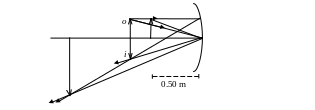PHYSICS 1 – CONCAVE LENSES AND MIRRORS CONCAVE LENSES
PHYSICS DEPARTMENT PROFORMA RESEARCH PROPOSAL CONFIRMATION FOR DIRECT1 PHYSICS OF BIOLOGICAL SYSTEMS CONRAD ESCHER HANSWERNER
10282004 PHYSICS 556714 NUCLEI AND ELEMENTARY PARTICLES PHY 556714
112 SPRINGS CALCULATION SHEET AQA PHYSICS QUESTIONS 1 WHEN
196 ANALYSING STARLIGHT FOLLOWUP SHEET OCR PHYSICS A WAVELENGTH
2 FOUNDATIONS OF PHYSICS CALCULATION SHEET OCR PHYSICS A
Concave Lenses and Mirrors
Physics 1 – Concave Lenses and Mirrors
Concave LENSES AND MIRRORS
Aims
To correctly setup an optics track.
To study how images are formed by simple concave mirrors and lenses.
To make measurements of object distances, image distances and focal lengths of concave mirrors and lenses.
To draw ray diagrams, with principle rays, for both experimental situations.
In this experimental tutorial you will first attempt a question which tests your knowledge and ability to draw principle ray diagrams concerning concave mirrors. Then you will perform the necessary experimental procedures to attain quality measurements, verifying theoretical prediction.
Part 1: Tutorial Question (10 mins)

A real image is produced by a concave mirror on the same plane as the object as shown opposite. The size of a real image, i, is trebled if the object, o, distance is decreased from 0.75 m to 0.50 m.
D
Figure 1
Calculate the radius of curvature of the mirror.
Draw the principle ray diagram.



Part 2: Using a concave mirror on the optical bench (15 mins)
In this part of the experimental tutorial you will set up the necessary equipment on the optical bench and determine the focal length of a concave mirror via two different methods and therefore verify the answer.
Calculating f through the measurement of the radius of curvature of a concave mirror, R.
Using the illuminated triangle in the lamp screen as an object, form a reflected image in the object plane using a concave mirror.
Draw a ray diagram of this arrangement, showing the principle rays for an extended object transverse to the principle axis.
The distance from the mirror to the image is the radius of curvature of the mirror, R.
Use the vertex pointer to find R.
For a mirror, the radius of curvature is related to the focal length of the mirror, f, by the following equation:
R = 2f
What is the focal length of your mirror?
Calculating f through the use of the mirror equation.
Using the same object as before, use a screen with a large aperture and form an image on this screen by reflection from the mirror.
The mirror equation relates the focal length of a mirror, or lens, to the object and image distances as follows:
![]()
Measure the object and image distances and hence calculate the mirrors focal length.
Comment on your two results for focal length i.e. do they compare well.
Part 3: Tutorial Question (10mins)

A
thin diverging lens is placed on an optical bench. Parallel beams
of light pass through the lens. On viewing the lens they appear
as if they came from a point 20cm before the centre of the lens,
as shown in figure 2. You want to use this lens to form a
vertical virtual image that is a third of the height of the
object.
(
Figure 2
(b) Draw a principle ray diagram.
Part 4: Using a concave lens on the optical bench (15 mins)
In this part of the experimental tutorial you will determine the focal length of a converging lens then observe the change when the same lens is used in conjunction with a diverging lens. Measuring this change accurately will enable you to calculate the focal length of the diverging lens.
Select a converging lens and place it into the holder on the optical track.
Use the illuminated triangle in the lamp screen as an object.
Form a bright image on the object plane by reflection from a plane mirror on the opposite side of the lens from the object, as shown in Figure 4.
What is the focal length of the convex lens?
The power, P, of a lens is related to its focal length by the
expression:
![]() ,
,
where f is measured in metres, and the units of P are dioptres.
4.2 Calculate the power of this lens.
Select the diverging lens and put it into contact with the converging lens.
Place the plane mirror on the opposite side of the object as before and form an image in the object plane. This image may be fainter so it’ll be harder to spot, and the object/image distance will be larger.
Beware of images formed by reflection, there will be two images formed by reflection from the lenses which you want to ignore.
Use the method for combined lenses to obtain the power of the lenses in contact.
Use PC = P1+P2 algebraically to calculate the power of the diverging lens.
4.3 Using your result for the power of the diverging lens calculate its focal length.
Part 5: Diverging lens and concave mirror (Optional)
On the optical bench set up the arrangement shown in figure 3; use a concave mirror of known radius of curvature. Hence take measurements to obtain the focal length of the diverging lens.
Further work
The following questions are related to the topic covered by this experimental tutorial.
Exercise book questions L1- L16.
Mastering Physics: Optics 1 (parts 5 and 6); Optics 2
Demonstrators' Answers, Hints, Marking Scheme and Equipment List
Marking Scheme
|
Section |
Mark |
|
1.1a |
0.5 |
|
1.1b |
1 |
|
1.1c |
0.5 |
|
2.1 |
1 |
|
2.2 |
1 |
|
2.3 |
1 |
|
3.1a |
0.5 |
|
3.1b |
0.5 |
|
4.1 |
1 |
|
4.2 |
1 |
|
4.3 |
1 |
|
Discretionary mark |
1 |
|
TOTAL |
10 |
Answers
1.1(a) The image moves away from the mirror.
1.1(b) ![]()
![]()
![]() m
m
1.1(c)

2.1 See Figure 1.
2.2/2.3 They should be very similar; differences tend to arise due to rounding of numbers.
3.1(a) From
the information given:![]() ,
therefore
,
therefore
![]() ,
i.e.
,
i.e.
![]()
so
substituting into
![]() gives
gives
 so
so
![]() m
m
and
![]() m
m
3.1(b)

Part 4: The power obtained for the concave lens should be a negative value.
Equipment List
Concave mirror
Concave lens
Convex lens
Plane mirror
Light source
Screen with triangular hole
Pointer
3 x saddles
3 x holders
Example Numbers
Part 2:
|
Quantity |
Pointer Measurement 1 (m) |
Pointer Measurement 2 (m) |
Length of pointer (m) |
Length (m) |
|
r |
0.571 |
0.734 |
0.2 |
0.363 |
|
|
|
|
|
|
|
f |
|
|
|
0.1815 |
|
|
|
|
|
|
|
s |
0.571 |
0.934 |
0.2 |
0.563 |
|
s' |
0.866 |
0.934 |
0.2 |
0.268 |
|
|
|
|
|
|
|
f |
|
|
|
0.1816 |
Part 3:
|
Quantity |
Pointer Measurement 1 (m) |
Pointer Measurement 2 (m) |
Length of pointer (m) |
Length (m) |
|
s1 |
0.571 |
0.698 |
0.2 |
0.327 |
|
s1' |
0.571 |
0.698 |
0.2 |
0.327 |
|
f1 |
|
|
|
0.1635 |
|
|
|
|
|
|
|
s2 |
0.578 |
1.246 |
0.2 |
0.8680 |
|
s2' |
0.578 |
1.246 |
0.2 |
0.8680 |
|
fc |
|
|
|
0.4340 |
|
|
|
|
|
|
|
P1 (dioptre) |
|
|
|
6.116208 |
|
Pc (dioptre) |
|
|
|
2.304147 |
|
P2 (dioptre) |
|
|
|
-3.81206 |
|
f2 |
|
|
|
-0.26233 |
2 SOLID STATE PHYSICS (INDIA) 45 (2002) XXXXXY PROCEEDINGS
20TH GAMOW INTERNATIONAL ASTRONOMICAL CONFERENCESCHOOL ASTRONOMY AND BEYOND ASTROPHYSICS
295407-electricity-sensing-waves-and-quantum-physics-mcq-topic-quiz-lesson-element
Tags: concave lenses, mirror concave, concave, lenses, physics, mirrors
- PHỤ LỤC 3A BCKHXHNV THÔNG TƯ SỐ
- “SEÑORA CÓNSUL SÍRVASE EXTENDER EN EL REGISTRO DE ESCRITURAS
- Inicial Instructivo Calibración Cronómetros Digitales Código Lm01tfi01 Revisión Versión
- CURRICULUM VITAE EUROPASS INFORMAŢII PERSONALE NUME PRENUME NICOLAE
- MEJORAMIENTO ESCUELA PRIMARIA ALDEA LOMAS SAN JACINTO CHIQUIMULA ESPECIFICACIONES
- REDNI BROJ ZAHTJEV ZA IZDAVANJEM JAMSTVA PROGRAM JAMSTVENOG
- PUBLIC INTEREST MAP (PIM) FOR QUEENSLAND GOVERNMENT BODIES FIGURE
- XV JORNADES DE CONSUM CRÍTIC SOBIRANIA ALIMENTARIA I PROCESSOS
- MISSOURI DEPARTMENT OF HEALTH AND SENIOR SERVICES ADVANCED
- MODELO DE COMUNICACIÓN AL PROTECTORADO DE LA CONSTITUCIÓN DE
- AGENDA CONSULTATION ON THE IMPACT OF FREE TRADE AND
- CHART 26 A WHERE AN INDIVIDUAL DISPOSES OF
- PORTAMATRICULAS ADAPTABLE A DUCATI MONSTER 696 08’09’ LICENSE SUPPORT
- II MENYAJIKAN DATA A PENGERTIAN MENYAJIKAN DATA MERUPAKAN TAHAP
- JAARGANG 31 NUMMER 7 OKTOBER 2011 PROTESTANTSE GEMEENTE SCHIERMONNIKOOG
- E SCUELA DE VOLUNTARIADO DE LA COMUNIDAD DE MADRID
- DANA JAMSTVA I IZDACI PO JAMSTVIMA U 2012 GODINI
- BIOMES OF THE WORLD POWERPOINT PROJECT STUDENT HANDOUT
- HRVATSKI ZAVOD ZA ZAPOŠLJAVANJE SREDIŠNJI URED ZAGREB 29052020
- YATIRIM TEŞVİK BELGESİ NEDİR ? YATIRIM TEŞVIK BELGESI TASARRUFLARI
- SUPPLEMENT TO THE ORGANIZATIONAL REVIEW 20042005 187 MEMBERS HAVE
- 5 CHAN 10833 – BRAHMS BRAHMS WORKS FOR SOLO
- BUZ MAKİNASI (KALE) KULLANIM TALİMATI FENEDEBİYAT FAKÜLTESİ KİMYA BÖLÜMÜ
- CIRCULAR OCEBA Nº 10 ELIMINACION DE LA CUOTA CAPITAL
- JANUARY 4 2003 THE MANAGEMENT OF ANEMIA IN PEDIATRIC
- GLUCOSE CONTROL IN THE HOSPITALIZED PATIENT EMERG MED 36(9)1218
- TEBLİĞ AMAÇ VE KAPSAM MADDE 1 – (1) BU
- EUROPASS ŽIVOTOPIS OSOBNÉ ÚDAJE PRIEZVISKO(Á) MENO(Á) OLEŠOVÁ
- ZNANSTVENA METODA INDUKCIJA DEDUKCIJA V NADALJEVANJU RAZMISLEKA O METODAH
- CAPACIDADES Y PROCESOS COGNITIVOS CAPACIDAD DEFINICIÓN PROCESOS COGNITIVOS CAPACIDADES
 ANSÖKNINGSBLANKETT STIFTELSEN FÖR PLURALISM HAR SOM SYFTE ATT
ANSÖKNINGSBLANKETT STIFTELSEN FÖR PLURALISM HAR SOM SYFTE ATTREGULAMIN STUDIÓW REGULAMIN STUDIÓW WARSZAWSKIEJ WYŻSZEJ SZKOŁY INFORMATYKI
CONSERVATION DISTRICT COAL BED METHANE PROTECTION ACT COMMITTEE’S STATEMENT
 4 PRESS RELEASE 23 JUNE 2016 SUMMER FILM SCHOOL
4 PRESS RELEASE 23 JUNE 2016 SUMMER FILM SCHOOL PRODUCCIÓN Y ALMACENAMIENTO DE HIDRÓGENO PRODUCCIÓN DE HIDRÓGENO INTRODUCCIÓN
PRODUCCIÓN Y ALMACENAMIENTO DE HIDRÓGENO PRODUCCIÓN DE HIDRÓGENO INTRODUCCIÓN SERVIR CENTRO VACACIONAL VILLETA POLÍTICA DE SOSTENIBILIDAD CORPORACIÓN
SERVIR CENTRO VACACIONAL VILLETA POLÍTICA DE SOSTENIBILIDAD CORPORACIÓNUNITED STATES DISTRICT COURT SOUTHERN DISTRICT OF NEW YORK
PRIMERA CIRCULAR XVI CONGRESO DE LA SEHM MEDICINA Y
OPERACIONI BLOK U NOVOJ ZGRADI DO KRAJA 2006GODINE OD
ITH124GA9 PÁG 3 CONVENCIÓN PARA LA SALVAGUARDIA DEL
 FUNDACIÓN GENERAL UPM SOLICITUD DE CONTRATACIÓN LABORAL PARA
FUNDACIÓN GENERAL UPM SOLICITUD DE CONTRATACIÓN LABORAL PARA GOVERNING BODY TEXAS ENTERPRISE ZONE PROGRAM MANDATORY ANNUAL REPORT
GOVERNING BODY TEXAS ENTERPRISE ZONE PROGRAM MANDATORY ANNUAL REPORTGIGANTES CON ASPAS —A LOS DOS DÍAS DE VOLVER
 CURSO SOBRE CADEIA DE CUSTÓDIA FSC® – IMAFLORA FORMULÁRIO
CURSO SOBRE CADEIA DE CUSTÓDIA FSC® – IMAFLORA FORMULÁRIO STUDENT NAME PERIOD MRS LEE –
STUDENT NAME PERIOD MRS LEE –USERRA OVERVIEW CAPTAIN SAMUEL WRIGHT JAGC USN (RET) PAGE
WISCONSIN’S MODEL ACADEMIC STANDARDS FOR SOCIAL STUDIES A GEOGRAPHY
 T C İSTANBUL ÜNİVERSİTESİ TEKNİK BİLİMLER MESLEK YÜKSEKOKULU BİLGİSAYAR
T C İSTANBUL ÜNİVERSİTESİ TEKNİK BİLİMLER MESLEK YÜKSEKOKULU BİLGİSAYAR BULLETIN DE FINANCEMENT N°64 LUNDI 31 OCTOBRE 2011 FONDATION
BULLETIN DE FINANCEMENT N°64 LUNDI 31 OCTOBRE 2011 FONDATIONSTEFAN JETCHICK 1450 AV DES GRANDSPINS QUÉBEC QC G1S
